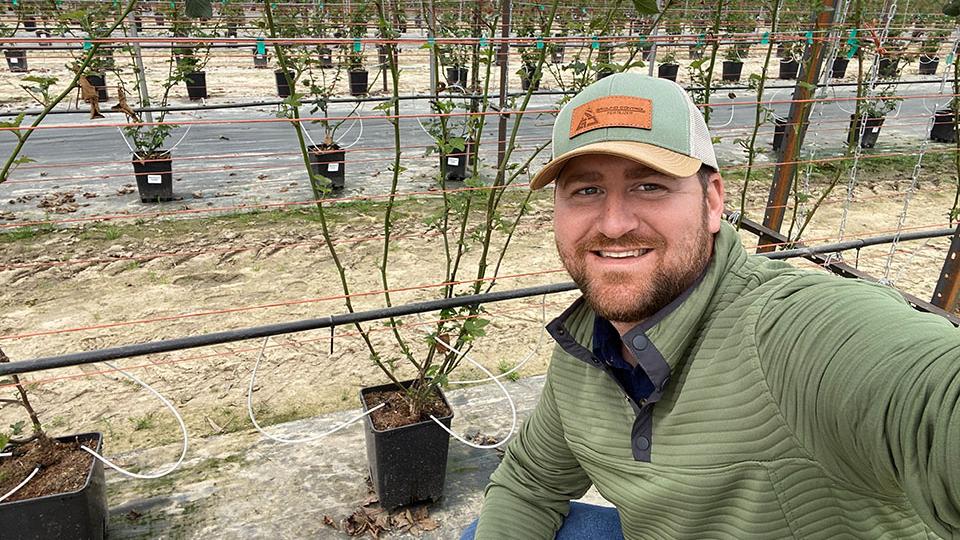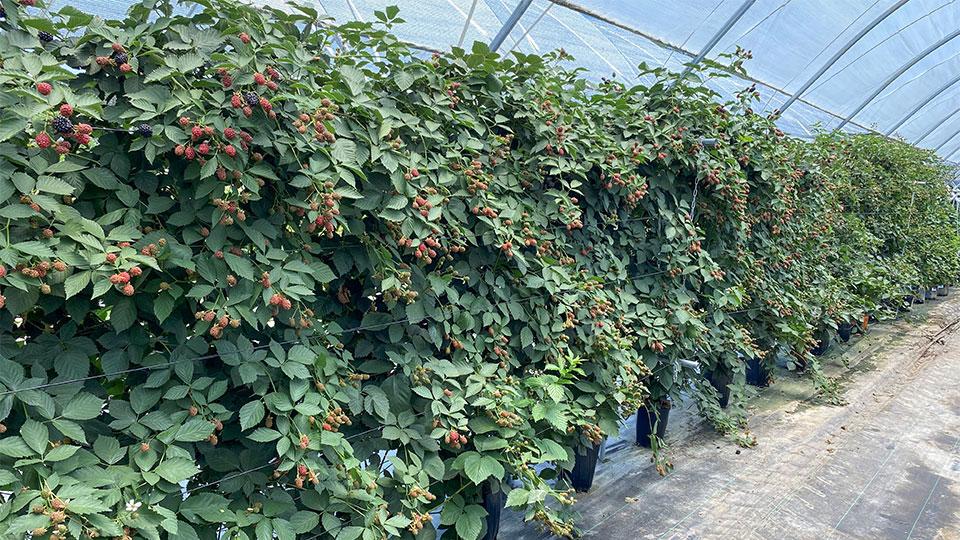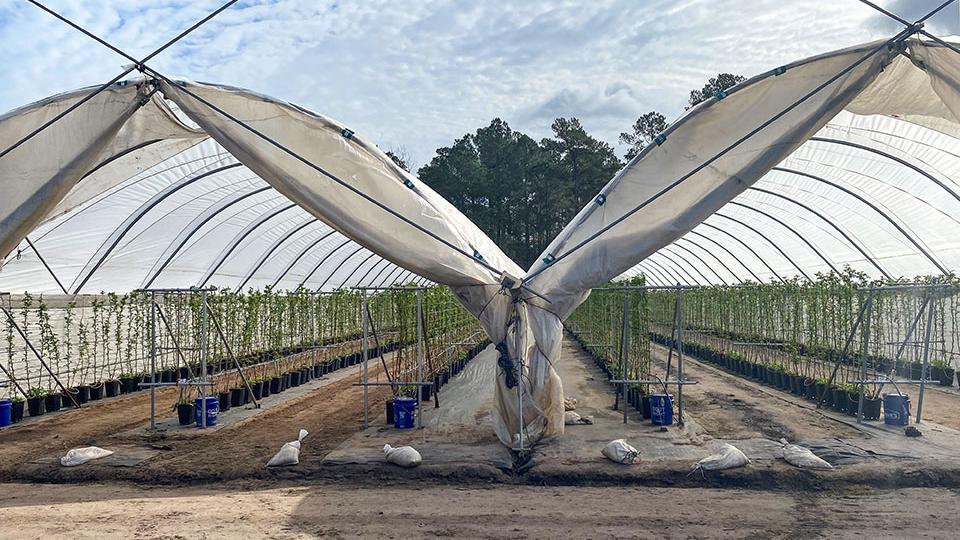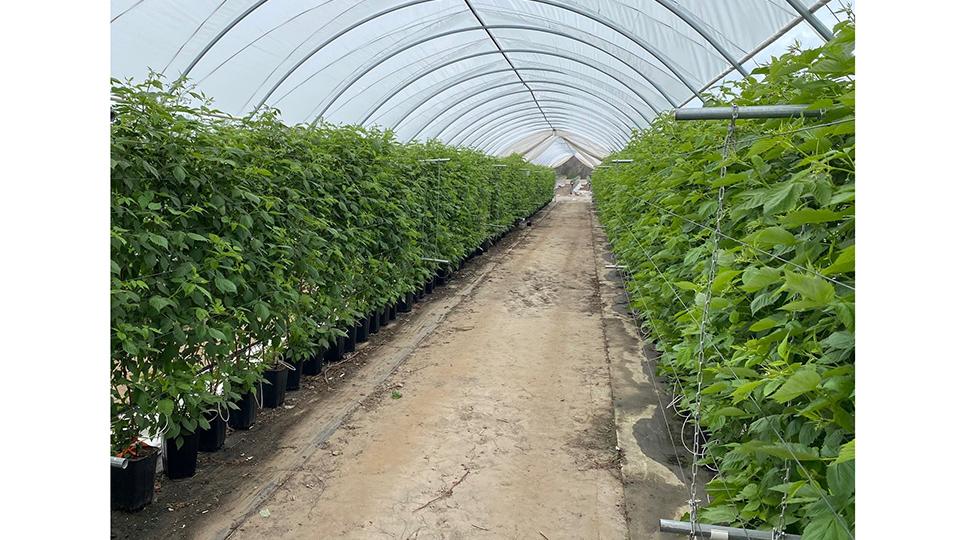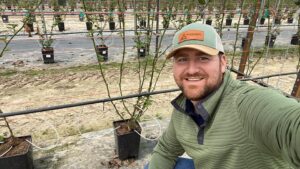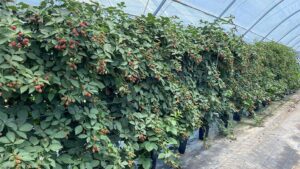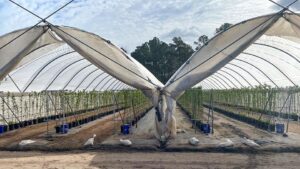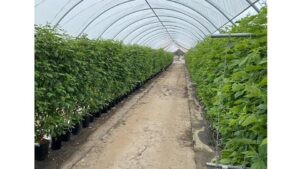Fertigation in Substrate: Doing it Right for Berries
Change occurs slowly in a traditional soil production system. On the plus side, this allows berry growers to make fertigation mistakes that are not completely detrimental. On the downside, soil deficiencies are more difficult to correct.
“If you have a set pH when you lay plastic and plant your crop, depending on your nutrient sources, especially nitrogen and sulfur values, it will take a while to change the system,” Josh Mays, Corporate Agronomist, TriEst Ag Group, Greenville, NC, says.
Substrate is nothing like that, Mays stresses. When fertigating in this scenario, growers can change pH almost daily, he says.
“Substrate systems are nowhere near as buffered as the soil system is. You have complete control, and that is a good thing, as long as what you are doing to control that crop is correct,” Mays says. “If it is the wrong thing, it can change rapidly. And those rapid changes lead to severe yield losses and pretty big mistakes.”
SUBSTRATE FEATURES
Rapid pH manipulation is possible in a substrate system through water treatment — such as running acids to pull pH down or potassium bicarbonate to pull it up — and fertilizer selection.
The substrate system is low volume and high frequency, typically featuring 2- to 3-minute run times over 20 to 30 times daily during peak canopy and peak fruit.
Rather than “x amount” of units per acre in a soil system, substrate fertility is driven by parts per million (PPM) targets of a constant feed that maintain certain fertility levels within that root zone.
Products used for fertigation in substrate systems, like potassium nitrate, potassium sulfate, calcium nitrate, and chelated/sulfate-based minor nutrients, are similar to those used in soil fertigation/drip systems, “just more of a dilution in a PPM target,” Mays says.
If water quality allows, calcium and sulfur can be delivered together in a system because it is so diluted. The two nutrients, when combined in poor water quality, can create solids and start to clog emitters, “which can be a nightmare,” Mays says. “You really have to pay attention to the cleanliness of the product that is in that line because it is sitting in there constantly. You’re not flushing it out. How clean that material is and how compatible the products are is important to keep a system running well.”
Water Quality
Growers need to know what is in their water before they can design their irrigation systems and begin to consider fertility inputs.
“If you don’t, you will be constantly chasing your tail and circling back, trying to make up for it,” Mays says. “Don’t put the cart in front of the horse.”
The consistency of the water is also critical. The key types of water sources in these systems are well, municipal or county water, and surface or pond water. The former is consistent in terms of alkalinity and bicarbonates, which allows cane berry growers to maintain the water coming in at a pH of about 5.5, Mays says. Surface water, however, can vary in consistency.
“You can see rapid pH changes, particularly around rainfall events,” Mays says. “That’s something we’re working through in some projects now to where we can monitor it and have a two-stage injection system where we’re using acids to pull that pH down or bicarbonates to push that pH up in a water source.”
Nuts and Bolts
Long cane raspberry growers can expect to average 14 to 20 run times per day for 2 to 3 minutes each instance, which means they must maintain a constant pressure system to guarantee uniformity of the nutrient solution in the black main lines from the front of the system to the rear. Because the run times are so short, growers also do not have time to charge these lines and move nutrients up through these emitters and into the drippers.
“If you’ve got 30 seconds of charge time, and you’re only running for 2 minutes, you’re not getting near the nutrient solution you think you are,” Mays says. “This system needs constant pressure on it, and as soon as soon as that pump cuts on, it tells these emitters to open, and it’s immediately emitting your fertilizer product.”
Run times and how much a grower irrigates are widely based on drainage. Growers typically want to stay at 40% to 50% soil moisture in their media while maintaining 15% to 20% drainage, Mays says. In turn, 20% of the total volume going into the pot should be draining out over the course of a day to guarantee adequate movement of the nutrients and water, he adds.
“It’s hard to put that on a schedule, because what happens on a morning that starts out cool — mid-40s and overcast — and turns into a bluebird sunshine 70- to 80-degree day in the afternoon? Those are rapid changes in the transpiration rates across those plants and how much water they’re going to pull,” Mays says. “It is a constantly managed system of paying attention to how much drainage you have, which dictates how much water you would run into the system.”
Two-Stage Injection Systems
With two injectors feeding products separately into a line, growers can run one tank on one irrigation run and the other tank on the next. Or they can run them simultaneously if water quality allows. But, in general, they are going to have a split system — featuring calcium and sulfur — running in at the same time, Mays says.
“Regardless of the equipment used, you need an injection system that can handle dilution rates of 1:100 to 1:300. You’re going to dilute that down to a target electroconductivity (EC) running into that plant,” Mays says. “The key is to have the EC you want, or the salt content, if you will, and the correct PPM makeup with the materials that are in your stock tank to constantly feed. Your ECs will change how much salt tolerance or how concentrated you want the fertilizer inputs going into that plant from the vegetative stage to the fruiting stage.”
Of note, long cane systems in the Southeast typically run during the winter months, so it is important that the fertilizer solutions remain above 50oF, particularly anything containing potassium, Mays says.
“The salt-out index of these materials, or when they will start separating and crystallizing, is important, and you can create a bad scenario in that fertilizer room pretty quick in the winter months,” Mays says. “So, it is important that that system would be heated.”
Fertilizer Sources
Water-soluble blends are the best option for a substrate system, because they allow for a lot of customization in a low volume product. They can require a lot of blending and mixing, which is manual labor and creates opportunities for mistakes.
“Somebody puts in 5 pounds instead of 0.5 pounds, and you can make mistakes really quickly,” Mays says. “In general, most growers land on water-soluble products. And there are many manufacturers of water solubles and many, many options to meet the same goal.”
Blended liquid fertilizers are also an option, but most of those businesses are set up for large acreage agricultural systems and don’t translate well to making very specific blends for such a low volume system like substrate.
Nutrient forms make a difference, especially regarding nitrogen, Mays says. “You want to focus on nitrate nitrogen in this system to keep your pH’s up and right. A large amount of ammoniacal nitrogen, and you will see significant pH drops, and it will cause you problems.”
Challenges and Unknowns
The biggest challenge for growers is major temperature swings, Mays says.
“We can get temperature swings of greater than 30°F to 40° in a given day or over the course of a couple of days,” he says. “This is not a set-it-and-leave-it-type system in the Southeast.”
Ideal pullout times are often in question. What are the best timings of managing market windows and temperature swings to get good fruit quality and a consistent product? Regarding varieties, is it a floricane? Is it a primocane? How aggressively growing is the plant? Is it early, or is it late?
“There are so many factors as we start to evaluate varieties in these substrate systems and how to dial everything in,” Mays says.
Finally, plant material consistency is critical in substrate systems, according to Mays.
“You have to start with a good plant. You’re building off the platform that was set by the nursery, and there are a lot of moving parts in this,” Mays says. “But it is an exciting platform for cane berries. I think we’ll see a lot of growth in this sector. We’re excited to be working on it.”





